 |
 |
|
 |
 |
|
 |
|
 |
 |
|
 |
|
|
|
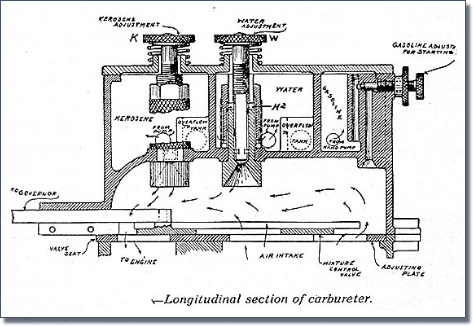 |
|
|
|
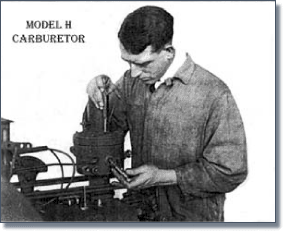 |
|
|
The fuel supply system of the Rumely Oilpull tractors is arranged so that kerosene, distillate and other low grade oils may be burned successfully. This, the Secor system, so named after its inventor, does not involve specially designed engines as any motor intended for operation on gasoline can be used successfully with kerosene if fitted with a Secor-Higgins carburetor. This is not a new system, by any means, because it was developed over fourteen years ago and has received practical application in thousands of power plants used for agricultural purposes during this period. The following matter, reproduced from the Scientific American Supplement, clearly outlines the essential features of the Secor system and also of the vaporizer used in connection with it:
|
|
|
|
|
Stated in brief terms, the system covers: (1) An automatic variation in the quantity of fuel mixture in accordance with the slightest variation in speed and load; (2) A degree of compression dependent upon the quantity of the mixture inhaled; (3) A correct proportioning of the mixture under all conditions, involving relatively weaker mixtures for higher compressions; (4) A temperature of combustion exactly adapted to the quality of fuel used and the compression; (5) Automatic control of the internal temperature through the admission of water as part of the fuel mixture; (6) Thorough and uniform mixture of fuel, water and air charge by mechanical means and without the application of additional heat; (7) Automatic variation in the time of firing in response to variations in speed and power; (8) Means for changing the limits of speed within which all factors are simultaneously controlled; (9) And means for starting on a limited supply of volatile fuel, all of which factors are vital to the control of internal heat, the transformation of heat into power and power production. The adaptability of the system described to the lower grade oils is secured through its providing a co-ordination of all factors at all times, this being considered necessary owing to the more difficult vaporization and combination of less volatile oils. The throttling governor, taking a different quantity of fuel mixtures for each cycle as the load varies, naturally produces a varying compression within the cylinder. It is well known that at higher compression leaner fuel mixtures may be, and should be used, and vice versa. One great factor in the success of the system is that through the mechanism of the special carburetor, the propertions of fuel, air and water are automatically varied in relation to each other as the comresssion changes. By this means the conditions within the cylinder, whether the engine is run at heavy load or light, are constant so far as they affect the completeness of combustion. Complete combustion eliminates the deposit of carbon which has been regarded as an insurmountable objection to the use of heavy fuels, and the unified automatic control results in the securing of splendid regulation.
The automatic control of the quantity of water is an original feature of the system, and is advantageous for several reasons. In the first place it makes for clean combustion by controlling the temperature of vaporization and combustion so that there is practically no cracking of the low-grade oil with its attendant carbon deposit. The water allows the use of higher compression, consequently greater power from the same bore, stroke and speed. The effect of the water in producing a slower-burning mixture is seen in a lower explosion pressure and a flatter indicator card. This results in as high a mean effective pressure as is found in gasoline engines of similar proportions, without the strain and instability produced by a violent initial shock. There is further, undoubtedly, a dissociation of water into nascent hydrogen and oxygen. The latter, being much more active than the diluted oxygen of the atmosphere, has naturally a greater affinity for any free carbon that may have been deposited at the moment of explosion. The hydrogen set free probably burns with the oxygen of the air as the temperature falls toward the end of the stroke, but it is doubtful whether enough steam is thus formed to exert any considerable expansive effect upon the piston. The process does, however, effectively scour the cylinder. The explosion is converted into a long, steady push instead of a short, sharp blow, and the water apparently gives an increase of power of at least 15 per cent over a similar engine without it.
|
|
|
|
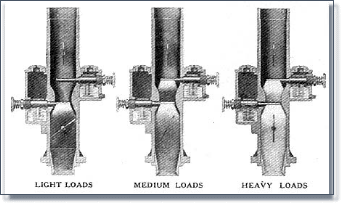 |
|
|
The water is not only controlled as to amount, but is brought into play automatically. As the load increases, the throttle opens and more air is sucked through the carburetor. Not until about half load is reached does the suction become strong enough to lift the water, hence it is not present to hinder ignition at light loads, nor to allow preignition at any time, being neither too heavy for ignition at heavy loads nor too light to control the temperature of vaporization.
|
|
|
|
|
Crankshaft, cam shaft, governor, magneto, carburetor, valves and piston act as a positively controlled unit in engines equipped with the new system, hence no one mechanical factor deserves to be set apart from the others in importance. However, the special carburetor, which makes possible the application of the new system, is of sufficient novelty to warrant special attention. A fly-ball governor, through a first-class lever and a link coupling, operates a sliding brass valve which is clearly shown in the the accompanying picture. The carburetor sits above the cylinders, with the short inlet manifold presenting little opportunity for the mixture to stratify before it is completely vaporized. It contains constant-level chambers for kerosene and water, an overflow being provided for each. It has also, for starting purposes, a chamber for gasoline which is filled by hand pump. This chamber, which holds about a pint, is connected by a siphon with the mixing chamber. Turning the engine over creates suction enough to draw upon the contents of this chamber, but a vent is provided so that if a start is not made immediately the siphon will not continue to act and drain the chamber.
|
|
|
|
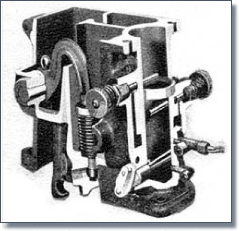 |
|
|
This image shows the position of the valve plate at light load. Two air inlets are then open, providing a large ratio of admission to outlet area and thus greatly reducing the relative vacuum in the mixing chamber. As the load increases, the governor throws the sliding valve forward, increasing the area of the outlet to the cylinder, increasing the air inlet in the middle, and decreasing or entirely closing the air opening at the right. Thus the ratio of admission to outlet area decreases, the relative vacuum becomes greater, and more fuel in quantity, though not in proportion, is picked up by the incoming air and carried to the cylinder.
|
|
|
|
|
A sectional view from the side shows the arrangement of the kerosene and water needle valves, the overflow, etc. It will be noted that the water level is lower than the kerosene level. The suction therefore is not great enough, until the engine reaches about half load, to lift the water to the point where it can flow down the tube surrounding the needle valve. From half to full load, the ratio of water to fuel increases rapidly until the amounts of fuel and water used are practically equal. The carburetor is so designed that the fuel needle-valve should be adjusted at the full-load position, when the plate is farthest to the right. This order of procedure is important, since at this position the adjustable plate has no effect upon the area of the air inlet openings. The adjustment of the air should be made at the "no-load" position and after once made, need never be changed, unless the engine enters a very different altitude. This adjustable plate allows each carburetor to be adjusted to the engine it is to serve, hence the slight variatoins in manufacturing are fully taken care of. The sliding plate is the only moving part in the carburetor, and that is positively controlled. There are no springs, floats or check valves. the device is simple, the parts are large and there is no possibility of the device getting out of order of failing to supply a correctly proportioned mixture as long as the pumps supplying fuel and water are functioning properly and the fuel and water containers are kept full.
|
|
|
|
From "The Modern Gas Tractor,"
by Victor W. Pagé, 1914
|
|
|
|
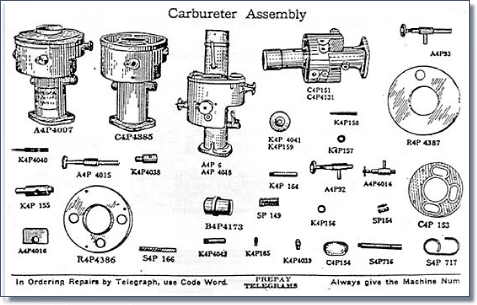 |
|
|
|
|
 |
 |
 |
 |
 |
 |
 |
 |
 |
 |
 |
 |
 |
 |
 |
 |
 |
 |
 |
 |
 |
 |
 |
 |
 |
 |
 |
 |
 |
 |